Servicios Personalizados
Revista
Articulo
Indicadores
-
 Citado por SciELO
Citado por SciELO -
 Accesos
Accesos
Links relacionados
-
 Similares en
SciELO
Similares en
SciELO
Compartir
Atmósfera
versión impresa ISSN 0187-6236
Atmósfera vol.15 no.4 Ciudad de México oct. 2002
Transfer function modeling of the monthly accumulated rainfall series over the Iberian Peninsula
VIDAL L. MATEOS, JOSE A. GARCIA, ANTONIO SERRANO and MARIA DE LA CRUZ GALLEGO
Dpto. de Física, Universidad de Extremadura, 06071 Badajoz, Spain
(Manuscript received June 12, 2001; accepted in final form April 3, 2002)
RESUMEN
Con el objeto de mejorar los resultados proporcionados por los modelos Autorregresivo - Media Móvil (ARMA) ajustados a las precipitaciones mensuales acumuladas registradas en 19 observatorios de la Península Ibérica se han usado modelos de función de transferencia (DLTFN) en los que se han empleado como variable independiente la presión local (LP), la presión a nivel del mar (SLP) o la temperatura de agua del mar (SST) en el Atlántico Norte.
En todos los casos analizados, los resultados obtenidos con los modelos DLTFN, medidos mediante la varianza explicada por el modelo, han sido mejores que los resultados proporcionados por los modelos ARMA. Los mejores resultados han sido dados por aquellos modelos que usan la presión local como variable de entrada, seguidos por los modelos que emplean la presión a nivel del mar, siendo los modelos que emplean la temperatura del agua del mar los que peores resultados proporcionan.
Con referencia a la situación geográfica, los modelos ajustados a los observatorios localizados al oeste de la Península dan mejores resultados que los ajustados a los observatorios situados al norte y este de la misma. Asimismo se ha encontrado que existe una región en el Atlántico Norte situada entre los paralelos 0o y 20°N donde la temperatura del agua parece tener alguna influencia sobre las precipitaciones peninsulares. Esta región se traslada hacia el norte cuando se emplean presiones a nivel del mar, a la vez que se intensifica su influencia.
ABSTRACT
In order to improve the results given by Autoregressive Moving-Average (ARMA) modeling for the monthly accumulated rainfall series taken at 19 observatories of the Iberian Peninsula, a Discrete Linear Transfer Function Noise (DLTFN) model was applied taking the local pressure series (LP), North Atlantic sea level pressure series (SLP)and North Atlantic sea surface temperature (SST) as input variables, and the rainfall series as the output series. In all cases, the performance of the DLTFN models, measured by the explained variance of the rainfall series, is better than the performance given by the ARMA modeling. The best performance is given by the models which take the local pressure as the input variable, followed by the sea level pressure models and the sea surface temperature models. Geographically speaking, the models fitted to those observatories located in the west of the Iberian Peninsula work better than those on the north and east of the Peninsula. Also, it was found that there is a region located between 0°N and 20°N, which shows the highest cross-correlation between SST and the peninsula rainfalls. This region moves to the west and northwest off the Peninsula when the SLP series are used.
Keywords: Autoregressive - Moving Average, Discrete Linear Transfer Function Noise, Rainfall Modeling.
1. Introduction
Autoregressive Moving Average (ARMA) models have frequently been used to parameterize accumulated monthly rainfall series (Delleur and Kavvas, 1978; Katz and Skaggs, 1981) and specifically to the Iberian Peninsula by Garrido and García (1993). In these models the rainfall series is regressed over itself lagged behind in time plus random noise. In an attempt to improve the results given by the ARMA models, Discrete Linear Transfer Function Noise models (DLTFN) were used (Box and Jenkins, 1976). There supposedly is a dynamic system where some variables (the predictors) act as inputs of this kind of model's system, and others (the predictands) as outputs, and that a change in the level of the input variables will produce a change in the output variables, though not necessarily at the same time. This implies a causal relation, in a statistical sense, between the input and output of the system. In the present paper the accumulated monthly rainfall series is taken as the output variable. For the input variables, one of the following is selected: monthly mean sea surface temperature (SST), which could be taken as a measure of the exchange of Sensible and Latent Heat between the ocean and the atmosphere, monthly mean sea level pressure (SLP), and monthly mean local station surface pressure (LP) (pressure measured at the same location as the accumulated monthly rainfall). The election of these variables was determined by the fact that according to Linés (1981) a good deal of the rainfall over the Iberian Peninsula is due to frontal systems coming from the North Atlantic Ocean, so that one might expect that a relation between the rainfall series measured over the Iberian Peninsula and the SST and SLP series over the North Atlantic Ocean could be established. The existence of such teleconnections between SST and SLP over the North Atlantic Ocean and large scale weather over Europe has been demonstrated by, amongst others, Ratcliffe and Murray (1970), Meehl and van Loon (1979), Barnett (1984). More specifically, the relation between SST and rainfall series has been studied, for example, by Nicholls (1989) in Australia, by Hastenrath et al. (1995) in South Africa, and in the Sahel by Folland et al. (1986), and Fontaine et al. (1995).
2. Data
The data to be analyzed in this study can be divided into two groups:
a. Continental data
These data account for the accumulated monthly rainfall series measured at 19 observatories throughout the Iberian Peninsula, whose geographic situation is given in Table I and displayed in Figure 1. It also indicates the mean monthly pressure series measured at those observatories. This set of observatories coincides practically with that used by Lorente (1985) and Linés (1981), and could be considered representative of the Iberian Peninsula. Most of the temporal series extend from 1901 to 1979.
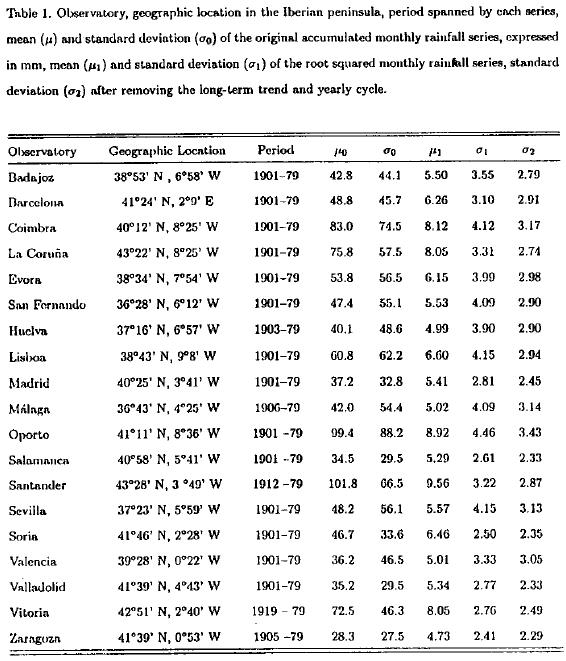

b. Ocean data
These data correspond to SST and SLP, and were obtained from groups 3 and 4 of the COADS (Comprehensive Ocean-Atmosphere Data Set) produced by the National Climatic Data Center of the USA (Woodruff et al., 1987). Both groups average over 10 degree latitude-longitude boxes in the region 0° N to 70° N and 10° E to 70° W. Figure 2 shows the box labels as used by COADS. The period spanned by these series also run from 1901 to 1979. The SST and SLP series were selected for subsequent analysis for each observatory in the Peninsula. These series, once deseasonalized and linear detrended, have the highest cross-correlation coefficient with each rainfall series square root transformed, deseasonalized and linear detrended (see below).
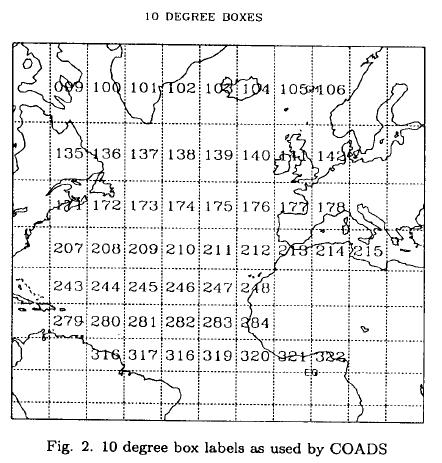
Tables 2 and 3 present the highest correlation coefficient of each rainfall series with the SST and SLP series respectively, along with their standard errors, estimated as ±1.96 times the lag-zero cross-correlation coefficient variance, which is given by Bennett (1979).



where rxx is the autocorrelation coefficient at lag k for the input series (SLP or SST), ryy is the autocorrelation coefficient at lag k for the output series (rainfall series) and rxy is the cross-correlation coefficient at lag k between the input and the output series. T is the period spanned by the series. The above sum was truncated at T/4.
The labels of the boxes with which the highest cross-correlation value is obtained and the significance level, the probability that the cross-correlation coefficient is significantly different from zero, determined using a bootstrap procedure (Efrom, 1993; Kahl et al., 1993) are also indicated. As observed in the SST table, except for Barcelona, Santander, Vitoria and Salamanca, the most repeated box is # 248 (see Figure 2 for the location of the boxes). To further analyze the relationship between the SST series and the rainfall series, a contour plot of the cross-correlation between each rainfall series and all the SST series was made. Figure 3 shows four cases (Evora, Madrid, Santander and Valencia) out of the nineteen contour plots obtained. As suggested by the Evora and Madrid plots, there is a belt from 20° N to 30° N and 10° W to 70°W that presents, however, significant positive cross-correlations between the SST and the the rainfall series. The results obtained for these two observatories are typical examples of those located in the west and southwest of the Peninsula. This is more clearly seen in Figure 2, which is a contour-plot of the cross-correlations between box # 248 and all of the rainfall series. Also, it was found that for some observatories (Coimbra, Evora, S. Fernando, Lisboa, Malaga, Oporto, Sevilla and Soria) there is a small area north of the positive cross-correlation region, with significant negative cross-correlation, leading to a kind of dipole with the positive cross-correlation region. An analysis of the cross-correlations between the rainfall series and the SST series formed as the difference between the positive and the negative region do not seem to improve the results obtained with the SST themselves. Hence, the SST series of the box with the maximum cross-correlations with the rainfall series will be used in subsequente analysis. As shown by Rowntree (1976), using a hemispheric model, a tropical ocean temperature anomaly causes a fall in surface pressure which extends well north of 60°N, which in turn induces an increase in rainfall at middle latitudes. These theoretical results match with our finding of a relationship between box # 248 and the rainfall over the Iberian Peninsula.

With reference to the SLP table, except for Barcelona, Santander, Vitoria and Zaragoza, boxes with greater cross-correlations are adjacent to the north, west and southwest of the Iberian Peninsula (boxes # 176, 177 and 212). In this case, the cross-correlation coefficients are notably higher than those obtained for the SST series, and they are negative, which means that the highest precipitations are obtained with low pressure centers situated in or near these boxes. As before, we made contour plots of the cross-correlation between each rainfall series and the SLP series, Figure 5 shows four examples of the contour plots obtained. The results for Evora and Madrid are representative of those obtained at observatories located in western and southwestern Spain. As the figure shows, the region in boxes # 176 and 212 presents the highest (negative) cross-correlation values. The relation between the rainfall over the Peninsula and the SLP over the above mentioned boxes is more clearly seen in Figure 6, which shows a contour plot of the cross-correlations between the average of the SLP boxes # 176, 177 and 212 with the rainfall series. It should be noted that, for the Santander observatory (and for Vitoria, not shown), the maximum cross-correlation region is a positive cross-correlation one, instead of the negative cross-correlation region obtained at the other observatories. This is related to most favorable synoptic situations that cause rainfall north of the Peninsula, as it will later be discussed

Prior to their use in DLTFN models, all the series were: i) Deseasonalized, by fitting them to the following function:

where only the yearly cycle and its first three harmonics have been included. No other period, apart from the annual, was found to be significant (Garrido and García, 1992). In the case of accumulated rainfall series, they were previously square root transformed in order to get an approximately normally distributed series (see Box and Cox, 1964; Delleur and Kavvas, 1978). Also, some peninsular pressure series were corrected for changes in location, ii) Detrended, by submitting each series to a homogeneity analysis (Mateos, 1993). In general, a linear trend was found to be enough to make the series stationary. iii) Finally, all the series were standardized, dividing them by their standard deviation. Table 1 shows the mean (μ) and the standard deviation (σ0) of the original rainfall series, the mean (μ1) and the standard deviation (σ1) of the square root-transformed rainfall series and the standard deviation (σ2) of the deseasonalized series.
3. Discrete linear transfer function models
a. Definition
Let y(t) and x(t) be a pair of series of data available at equally spaced intervals of time Δt, taken usually as 1, that could be considered as output and input of some dynamic system. y(t) and x(t) are supposedly related through a linear filter:

where B is the backshift operator Bx(t) = x(t - 1). The polynomial V(B) = v0 + V1B + v2B + ... is the transfer function of the filter. Weights v0 ,v1, ... are called the input response of the system. The problem with equation (2) is that it has an infinite number of parameters. A parsimonious class of discrete linear transfer function models is given by (Box and Jenkins, 1976):

or

where δ(B) and ω(B) are polynomials of order r and s respectively. Equation (4) can be written as

Equating (2) and (5), produces a relation between δj, ωj, and vj. Noise has to be added to the input because the system is usually perturbed by unknown factors, not taken into account by the input x(t),:

where n(t) represents the external noise which is usually shaped as an ARMA model,

Φ (B) and Ψ (B) being two polynomials of orders p and q in the backshift operator B, and a(t) white noise. The final form of the DLTFN is

b. Parameter estimation
The parameter estimation is carried out in four steps. See Box and Jenkins (1976) for a full description of the fitting process.
Identification of the model: From the cross-correlation function between the input series xt and the output series yt, weights  are estimated, from which the coefficients of the polynomials
are estimated, from which the coefficients of the polynomials  and
and  are obtained for some selected values of the orders r and s. In this case, all possible combinations of 1 ≤ r ≤ 4 and 1 ≤ s ≤ 4, were tried keeping the one that gave minimum noise variance for subsequent analysis. Also, the roots of the
are obtained for some selected values of the orders r and s. In this case, all possible combinations of 1 ≤ r ≤ 4 and 1 ≤ s ≤ 4, were tried keeping the one that gave minimum noise variance for subsequent analysis. Also, the roots of the  polynomial were evaluated in order to assure the stability of the model. In all cases, the minimum noise variance model was found to be stable.
polynomial were evaluated in order to assure the stability of the model. In all cases, the minimum noise variance model was found to be stable.
Identification of the noise: An estimate  of the noise of the system is provided by subtracting the estimate
of the noise of the system is provided by subtracting the estimate  from the observed output of the system y(t), given by
from the observed output of the system y(t), given by

Once the noise series has been obtained, it is ARMA modeled

where a(t) is white noise.
Parameter estimation: The final estimate of the parameters was obtained by fitting the series {x(t),y(t)} to Equation (8) by a non-linear least squares method using the Levenberg-Marquardt algorithm. The order of the model, i.e. r, s, p, q and the initial parameters for the non-linear least squares algorithm are those obtained in previous steps. A 100(1-α)% confidence interval for the parameters was calculated according to Box and Jenkins (1976).

where δβi is the confidence interval for each parameter of the model, σa2 is the noise variance and Cii are the main diagonal elements of the covariance matrix (X'X)-1, where X is the Jacobian  at the minimum,
at the minimum,  is a two-tailed 100
is a two-tailed 100 % critical value of Student's t, and α is taken to be 0.05.
% critical value of Student's t, and α is taken to be 0.05.
Checking the model:
The adequacy of the fit was tested by comparing the statistics (see Box and Jenkins (1976) for a thorough discussion)

against a χ2 with K - m - n degrees of freedom, where m, n are the orders of the ARMA model fitted to the noise n(t) and M = N - p is the number of values of a(t) that are actually available for computation, and statistics purposes

against a χ2 with K + 1 - (r + s + 1) degrees of freedom, where (r + s +1) is the number of parameters fitted in the DLTFN model. The Q test checks the adequacy of the noise model, and the S test the adequacy of the DLTFN model.
4. Forecasting
One of the main goals of time stochastic models is to forecast future values of the observed series y(t). The method proposed by Box and Jenkins (1976) was followed. Using square brackets to denote conditional expectation at time t, and  and
and  to denote lead-l forecasts of y(t) and x(t):
to denote lead-l forecasts of y(t) and x(t):

where

The a(t) series is calculated as  , and the
, and the  series is obtained from the ARMA model fitted to the input series that was used for pre whitening. The variance of the lead-1 forecast is given by
series is obtained from the ARMA model fitted to the input series that was used for pre whitening. The variance of the lead-1 forecast is given by

5. Results and discussion
For each accumulated rainfall series analyzed (one per observatory), three DLTFN models were obtained, one for each input series: LP, SST and SLP. An ARMA model was also fitted for comparison.
Tables 4 to 6 (5) give the orders of the DLTFN models obtained, and Table 7 the orders of the ARMA models. The residual variance is also listed. Tables 8 to 10 (9) give the results of the S and Q tests. The tables present the values of Q and S obtained using Equations (12) and (13) with K = 100, the degree of freedom v and the χ2 critical value at a 5% level of significance. The model is not rejected when Q, S ≤ χ2. According to these tables, the models are rejected in only a few cases [San Fernando, Huelva (Q test, LP/rainfall), Barcelona (Q test, SST/Rainfall)].
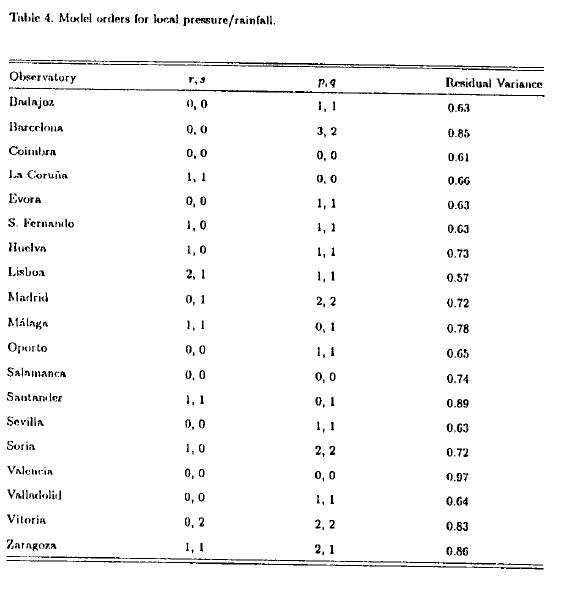

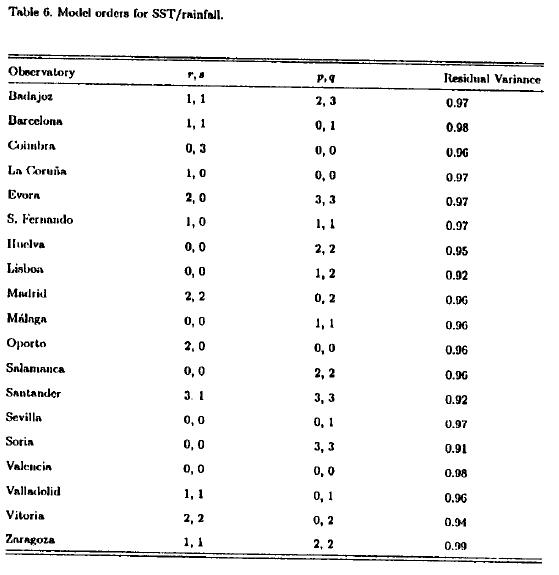
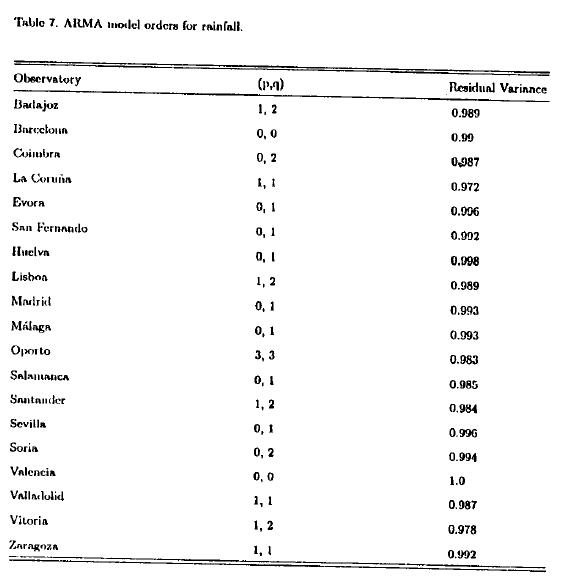



The best fit, measured by the variance reduction, is obtained when LP is the input variable, followed by SLP. The worst is obtained for the SST input series. In all cases, the variance reduction obtained with the DLTFN models is greater than the reduction in variance obtained with the ARMA models.
For the LP/rainfall models the explained variance is greater in observatories near the Atlantic coast. In moving away from the Atlantic, the explained variance decreases. The worst case (in terms of the explained variance) is obtained for Barcelona and Valencia on the Mediterranean coast, and for Santander and Vitoria near the Bay of Biscay. This is clearly seen in the contour plot of the explained variance displayed in Figure 7.
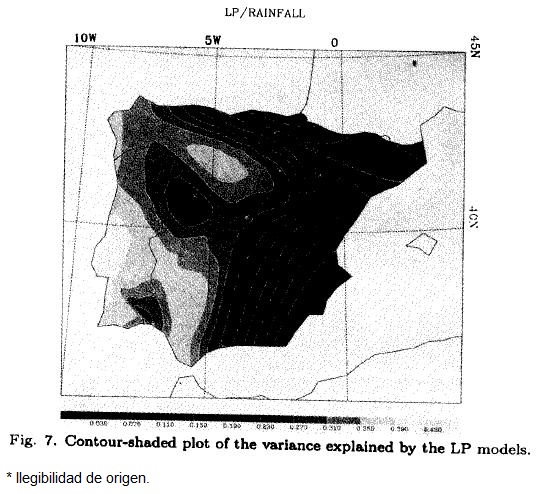
With reference to the SLP/rainfall models, Figure 8 shows a contour plot of the explained variance.
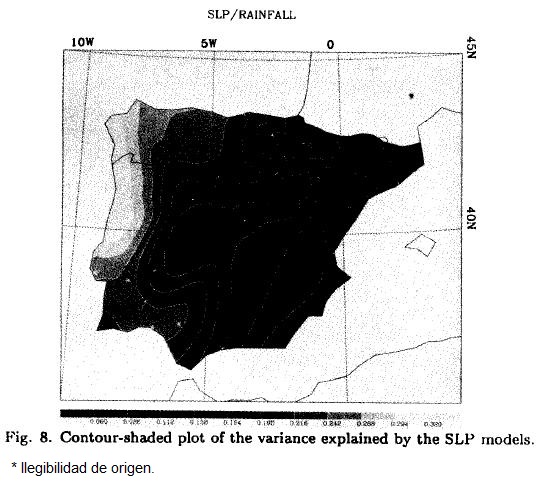
As before, the models work better for the observatories situated in the northwestern part of the Iberian Peninsula, decreasing in quality of performance as approaching the Mediterranean coast.
For the SST/rainfall models, Figure 9 presents the results of the explained variance. The explained variance is so low that there seems to be no definite region where the models work better than in others (except perhaps for Soria, which is believed to have no climatological significance).

As Table 4 shows, most of the models present either a zeroth-order polynomial ω(B) or an ω(B) with its first- order coefficient ω1 much smaller than the zeroth-order coefficient ω0. This means that the models are really diagnostic rather than prognostic, and their forecasting ability will really be that of the ARMA models fitted to the input series xt. Because in practically all the cases analyzed (LP, SLP and SST) these ARMA models behave as white noise, the forecasting models only for the most favorable cases should be develped, that is, when the LP are the input series, and using the models as diagnostic rather than prognostic models. Hence, we shall limit the research to the observational period, to using a lead-1 forecast, and to using the observed pressure value instead of the predicted value when applying Equation (14). In order to compare the forecast value with the observed one, the path followed to the normalization has to be reversed, i.e., Equation (1) must be replaced by

where yr(t) is the forecast value given by the DLTFN model using (14) and σ2 is the standard deviation of the deseasonalized rainfall series. The square has been added because the rainfall series were previously square root transformed. A 100(1-α)% confidence interval for the forecast value was calculated as

where  is a two-tailed 100α% critical value of Student's t, and α is taken to be 0.05. V(1) is the variance of the lead-1 forecast. Figure 10 shows the results obtained at some observatories. Filled circles show the observed values while open circles indicate the forecast ones. The error bars are the confidence intervals calculated using (17). As the figure shows, the forecast values are not much too different from the observed ones, but the error bars are quite large due to the high variance left unexplained. Obviously, observatories with smaller lead-1 forecast variance show smaller error bars. This is easily seen by comparing the results of Valladolid or Madrid with those of La Coruña or Lisboa.
is a two-tailed 100α% critical value of Student's t, and α is taken to be 0.05. V(1) is the variance of the lead-1 forecast. Figure 10 shows the results obtained at some observatories. Filled circles show the observed values while open circles indicate the forecast ones. The error bars are the confidence intervals calculated using (17). As the figure shows, the forecast values are not much too different from the observed ones, but the error bars are quite large due to the high variance left unexplained. Obviously, observatories with smaller lead-1 forecast variance show smaller error bars. This is easily seen by comparing the results of Valladolid or Madrid with those of La Coruña or Lisboa.
In order to better understand the results, we must analyze the origin of precipitation over the Iberian peninsula. The classical works on this topic are those of Linés (1981), who analyzed the perturbations and the associated rainfall that affect the Iberian Peninsula, Font (1983), who made a classification of the different weather types that affect the Peninsula, and more recently Marroquin et al. (1995), who analyzed the synoptic situations that seem responsible for the daily rainfall over Badajoz (one of the observatories studied, and a typical example of these results) and Ribalaygua and Borén (1996), who analyzed the relationship between the daily synoptic situations and the daily rainfall patterns over the Peninsula.
According to the results obtained by the aforementioned authors, a good deal of the rainfall over most of the Iberian Peninsula is related to the passages of fronts, moving eastward, with the associated low pressure center located in or near boxes #176, 177 and 212. This kind of synoptic situation is particularly important for the western two-thirds of the Iberian Peninsula, whereas the Mediterranean coast rainfall has a major convective and orographic origin with westerly flow and a low located in the Gulf of Genova (Catalonian rainfall) or the Gulf of Cadiz (Valencia rainfall). Also a good deal of the rainfall over the Gulf of Biscay coast is associated with a northern flow with high pressures west of the British Isles, and a low in the Gulf of Genova. Our results agree fairly well with the above in that:
• The LP/rainfall models work well for the western part of the country (rainfall due to frontal passage).
• The SLP/rainfall models work well for the western part of the country (lows located to the west/northwest of the Peninsula).
6. Summary and conclusions
In order to try to improve the results given by ARMA modeling of monthly accumulated rainfall series, a Discrete Linear Transfer Function Noise model was used, thus introducing new information given by an external variable - in this case, North Atlantic SST, SLP and Local Pressure, LP.
The preliminary analysis shows that there is a small but significant relation between SST measured along a belt from 10 to 20°N and the rainfall measured at observatories on the west and southwest of the Iberian Peninsula. This relation is much greater when the SLP data are taken as input variables. In this case, the highest correlation North Atlantic zone stretches from 30 to 50°N and lies just to the west of the Iberian Peninsula.
In all cases analyzed, the performance of the DLTFN models, measured by the explained variance of the rainfall series, is better than that of ARMA models. The model that 'works' best is the one where the input variables are LP, followed by SLP, and SST.
In most of the models, the first coefficient ω1 of the polynomial ω(B) is either zero or much smaller than the zeroth-order coefficient ω0, which means that the models are diagnostic rather than prognostic. We therefore used them as a prognostic tool, keeping our 'forecasting' within the observational period.
Acknowledgements
Thanks are due to the Instituto Nacional de Meteorología of Spain for providing us with rainfall and local pressure data, and to the Spanish CICYT for their financial support, project number CLI96-1871-C04-03. Thanks are also due to the anonymous reviewers for their useful comments.
REFERENCES
Barnett, T. P., 1984. Statistical prediction of seasonal air temperature over Eurasia. Tellus, 36A, 132-146. [ Links ]
Bennett, R.J., 1979. Spatial Time Series. Pion Limited. London. [ Links ]
Box, G. E. P. and D. R. Cox, 1964. An analysis of transformations. J. Roy. Statis. Soc., Ser. B, 26, 211-252. [ Links ]
Box, G. E. P. and G. M. Jenkins, 1976. Time Series Analysis: Forecasting and Control (rev.). Holden-Day. San Francisco. [ Links ]
Delleur, J. M. and M. L. Kavvas, 1978. Stochastic models for monthly rainfall forecasting and synthetic generation. J. Appl. Meteor., 17, 1528-1536. [ Links ]
Efrom, B. and R. J. Tibshirani, 1993. An Introduction to the Bootstrap. Chapman and Hall. New York. [ Links ]
Folland, C. K., T. N. Palmer and D. E. Parker, 1986. Sahel rainfall and the worldwide sea temperatures 1901-85. Nature, 320, 602-607. [ Links ]
Font, I., 1983. Climatología de España y Portugal, Instituto Nacional de Meteorología, Madrid, Spain. [ Links ]
Fontaine, B., S. Janicot and V. Moron, 1995. Rainfall anomaly patterns and wind field signals over West Africa in August (1958-1989). J. Climate, 8, 1503-1510. [ Links ]
Garrido, J. and J. A. García, 1992. Periodic signals in Spanish monthly precipitation data. Theor. Appl. Clirnatol., 45, 97-106. [ Links ]
Garrido, J. and J. A. García, 1993. Aplicación de los procesos de autoregresivos-media móvil para modelizar series temporales de precipitación en la España peninsular. Anales de Física, 89, 50-56. [ Links ]
Hastenrath, S., L. Greischar and J. van Heerden, 1995. Prediction of summer rainfall over South Africa. J. Climate, 8, 1511-1518. [ Links ]
Kahl, J. D., D. J. Charlevoix, N. A. Zaitseva, R. C. Schnell and M. C. Serreze, 1993. Absence of evidence for greenhouse warming over the Arctic Ocean in the past 40 years. Nature, 361, 335-337. [ Links ]
Katz, R. W. and R. H. Skaggs, 1981. On the use of autoregressive-moving average processes to model meteorological times series. Mon. Wea. Rev., 109, 479-484. [ Links ]
Linés, A., 1981. Perturbaciones típicas que afectan a la Península Ibérica y precipitaciones asociadas. Instituto Nacional de Meteorología de España, Madrid. [ Links ]
Lorente, J. M., 1985. La variabilidad de las precipitaciones atmosféricas sobre la España peninsular. Revista de Geofísica XIV, Madrid. [ Links ]
Marroquin A., J. A. García, J. Garrido and V. L. Mateos, 1995. Neymann-Scott cluster model for daily rainfall processes in Lower Extremadura (Spain). Rainfall generating mechanisms. Theor. Appl. Clirnatol. 52, 183-195. [ Links ]
Mateos, V. L., 1993. Modelos de Función de Transferencia para series de precipitación en la península Ibérica, Ph. D. Thesis, Universidad de Extremadura, España. [ Links ]
Meehl G. A. and H. van Loon, 1979. The seesaw in winter temperatures between Greenland and northern Europe. Part III: Teleconnections with Lower Latitudes. Mon. Wea. Rev., 107, 1095-1106. [ Links ]
Nicholls, N., 1989. Sea surface temperature and Australian winter rainfall. J. of Climate, 2, 965-973. [ Links ]
Ratcliffe, R. A. S. and R. Murray, 1970. New lag associations between North Atlantic sea temperature and European pressure applied to long-range weather forecasting. Quart. J. Roy. Meteor. Soc. 96, 226-246. [ Links ]
Ribalaygua, J. and R. Borén, 1996. Clasificación de Patrones de Precipitación Diaria Sobre la España Peninsular y Baleárica, Informe N°3, Servicio de Análisis e Investigación del Clima, Instituto Nacional de Meteorología, Spain. [ Links ]
Rowntree, P. R., 1976. Response of the atmosphere to a tropical Atlantic Ocean temperature anomaly. Quart. J. R. Met. Soc., 102, 607-625. [ Links ]
Woodruff, S. D., R. J. Slutz, R. J. Jenne and P. M. Steurer, 1987. A comprehensive ocean-atmosphere data set. Bull. Amer. Meteor. Soc., 68, 1239-1250. [ Links ]














